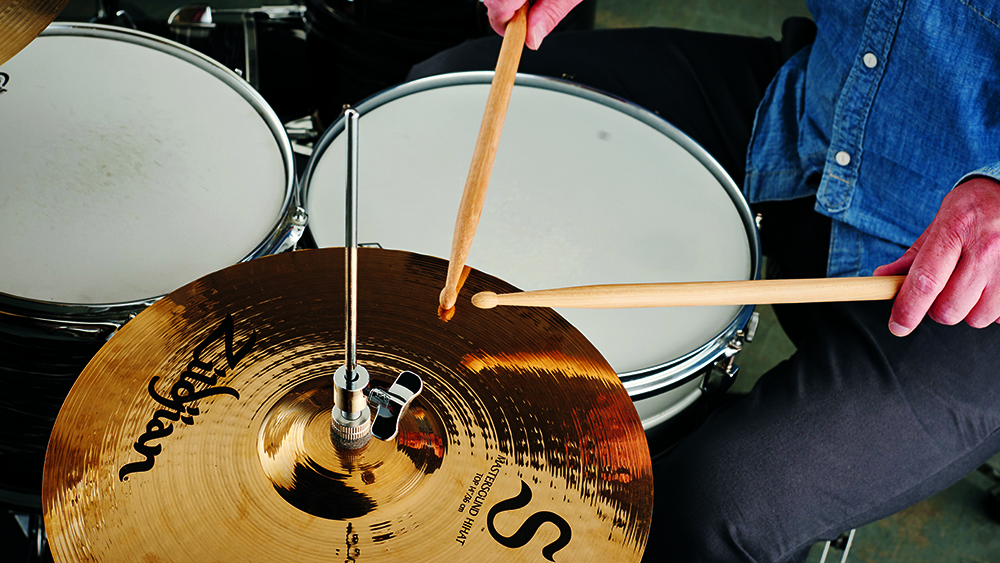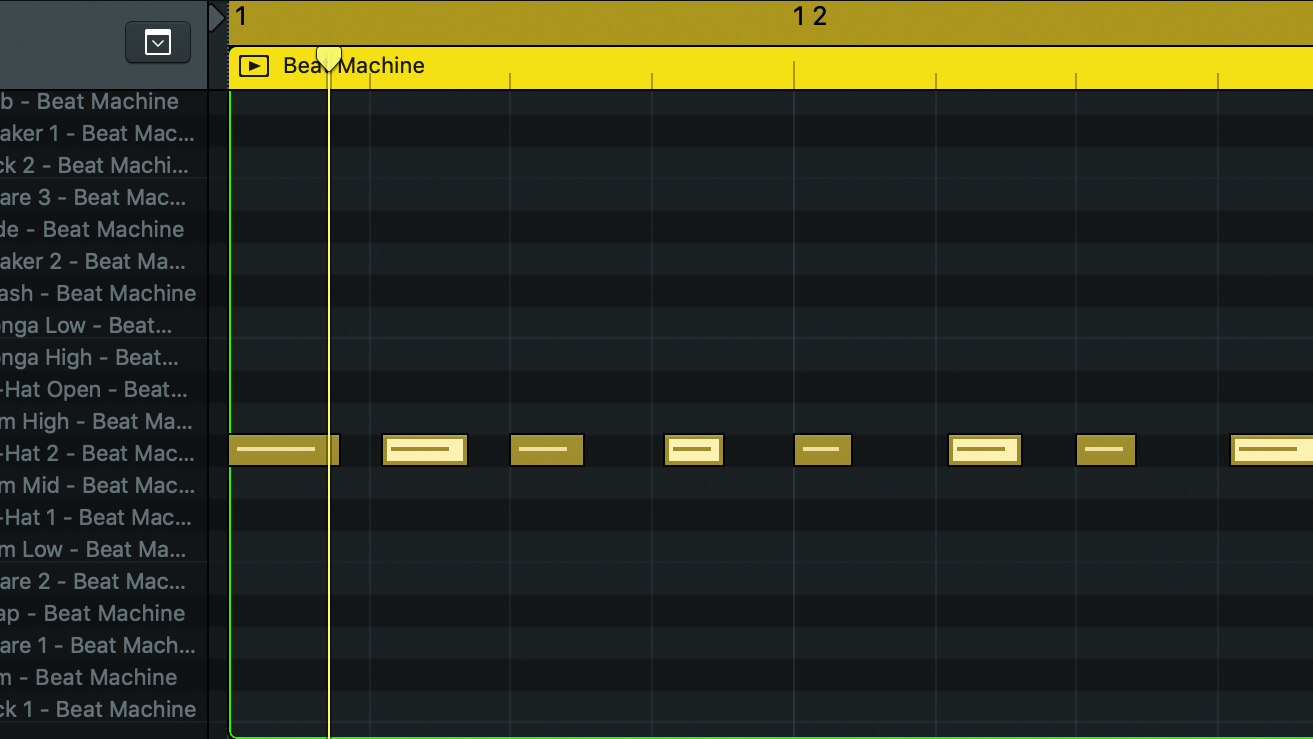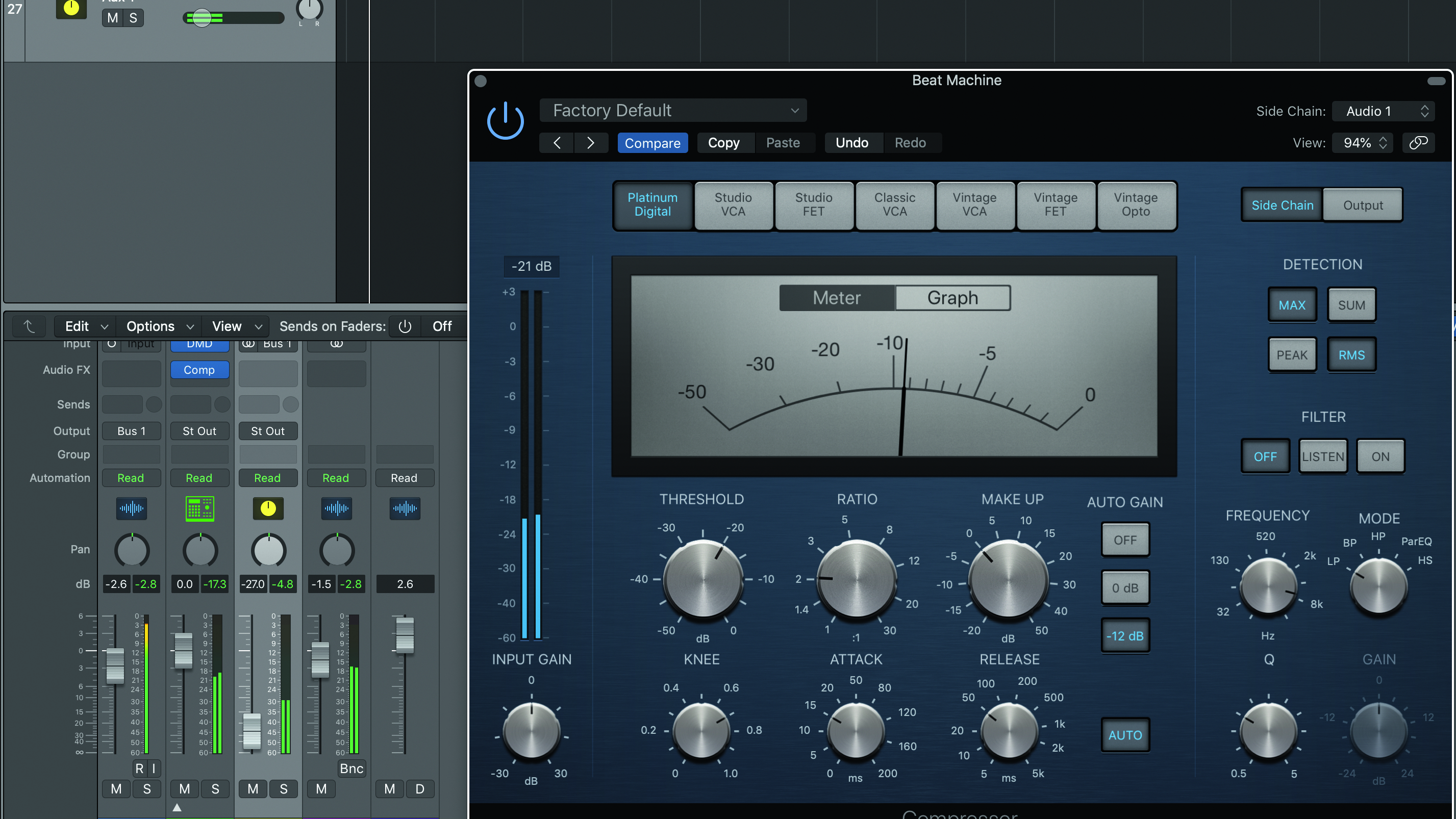How to create the perfect hi-hats and cymbals
Let’s add some sizzling metalwork to our kit

The hi-hats are a pair of cymbals mounted on a stand, one upside down and the other the right way up, both held in place on a central spike and connected to a footpedal at the base of the stand.
By operating the pedal, the drummer brings the hi-hats together. If you watch a jazz drummer play, you’ll see that the hi-hats spend most of the time closed, but open and shut quickly on the second and fourth beats of the bar. In just about all other modern styles the hi-hats are kept closed or half-closed and played with sticks, anchoring the drum track by beating out eighth-notes.
The role of the hats is to give life to the kick and snare pattern. Acoustic hats vary from small, thin and bright (jazz, pop, dance) to big, thick and dark (rock), and only really have four sounds: closed, half-closed, open and pedalled. Of course, each of these has endless tonal variations, as a browse through any good drum sample library will illustrate.
A good drummer or programmer will use accents (where certain hits are louder than the others) to bring what might otherwise be a boring hi-hat pattern to life, but as well as the volume, a skilled player or programmer will play around with the timing.
Moving or playing the hi-hat part slightly ahead of or behind the beat will subtly change the feel of the groove, making it feel more urgent or laid back. In dance music, the kick is almost always quantised exactly to the grid, but moving other elements around can create a much groovier feel. A bit of swing will slightly delay every other beat in a pattern of 16ths, creating a ‘shuffle’ feel. The quantise functions in your DAW will have loads of variations of swing for you to experiment with.
Crash and ride
The two other essential cymbals are the crash and the ride. There are others, like China-types and splashes, but they’re just smaller and ‘trashier’ variations on the crash, respectively.
The ride cymbal sounds with a clear ‘ping’ followed by a wash of airy overtones. It’s generally used as an alternative to the hi-hats, changing the feel of the drum track for the chorus or middle eight. There are many flavours: light and thin for jazz, dark and heavy for rock – some jazz drummers even use ride cymbals fitted with loose rivets or fine chains for exaggerated sizzle and ‘air’. Crashes are there to mark occasional accents in the song (the ends of significant phrases, mostly), and it’s really just a question of choosing one that you like from the endless samples available.
Artificial energy
It’s tempting to add energy to a section of your mix by ramping up the cymbals, and a powering crash or sizzling half-open hat certainly does sound exciting. A good test of the dynamics of your music, though, is to turn the cymbals off. Is it still dynamic? Does the music itself have energy? If the only thing adding change or excitement is the cymbals, you have a mix that will become boring very quickly. Cymbals should be there to enhance and articulate the musical energy, not be the source of it. Some great pop tracks even contain no cymbals at all – Hey Ya! by Outkast springs to mind.
Get the MusicRadar Newsletter
Want all the hottest music and gear news, reviews, deals, features and more, direct to your inbox? Sign up here.
To achieve cymbal perfection, you need to set your cymbals at the right level in the mix and not add too much high-frequency EQ. Controlling levels is easy with samples but far less simple when recording a live drummer, as cymbal spill can dominate. A wall of guitars or constant ride soon becomes like white noise, so pick your moments.
Sidechaining hi-hats for swing

Step 1: Working with a 16th-note hi-hat pattern, start by selecting every other hit, then move the selected hats forwards slightly (only a few ticks). You’ll hear a swung feel start to emerge. The further to the right you move your hi-hats, the more swung the beat becomes.

Step 2: Now create an auxiliary send from your kick drum channel at 0dB (if you’re using Logic, this is done from the Options menu – other DAWs will vary but it’s usually pretty easily done). Ensure that the aux send is pre-fade so that it continues to send the same amount of signal even if you turn the channel fader down.

Step 3: Insert a sidechain-enabled compressor plugin into your hi-hat channel and route the kick drum channel to the sidechain input. Now the hi-hats will be compressed when the kick hits and come back up in level in between.

Step 4: With the pattern running, lower the Threshold on the compressor until you see gain reduction happening on the meter. Then play with the Attack and Release times until you get the hi-hats pumping nicely in between the kicks. You may
need to up the Gain to make up for the volume decrease.
Cymbal programming tips
Physical realism
‘Be’ the drummer! If you’re aiming to program realistic sounding hi-hats and cymbals, it’s important to remember the mechanics of what a real player would do. A drummer only has two arms, so make sure no more than two cymbals are ever hit at the same time – and that’s without the snare or toms, of course.
Duplicate hats
Many ROMplers and ‘virtual drummers’ automatically apply mute groups to hi-hat samples, meaning that a closed hat will end the decay of an open one. Although this mimics reality, it’s often good to disable it or have a duplicate hi-hat that you can use for overlapping pedalled and half-open hits – set up your own ‘choke’ key if you need one.
Multi-hats
For floor-filling dance music productions, try placing one hi-hat sound on each kick drum to help it poke through the mix, and use a totally different one for the main pattern. And why stop there when you can add a third one for accents, too?
Bus compression
Adding the hi-hats and cymbals to your main drum bus and inserting a compressor into it will help bring your patterns to life and make the cymbals sound like they’re part of the kit. The big bottom-end frequencies of the kick and low mids of the snare will activate the compressor and cause the cymbals to duck, mimicking the way in which we hear loud sounds in the real world.
Computer Music magazine is the world’s best selling publication dedicated solely to making great music with your Mac or PC computer. Each issue it brings its lucky readers the best in cutting-edge tutorials, need-to-know, expert software reviews and even all the tools you actually need to make great music today, courtesy of our legendary CM Plugin Suite.
“I’m surprised and saddened anyone would have an issue with my performance that night”: Zak Starkey explains why he got fired from The Who
“These tariff actions will have a long-term effect on musicians worldwide”: The CEO of NAMM urges Trump to dump tariffs on components of musical instruments
Brace yourself: Bryan Adams didn’t buy his first real six-string in a five and dime










